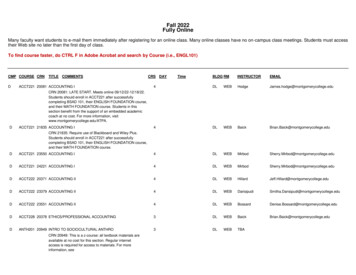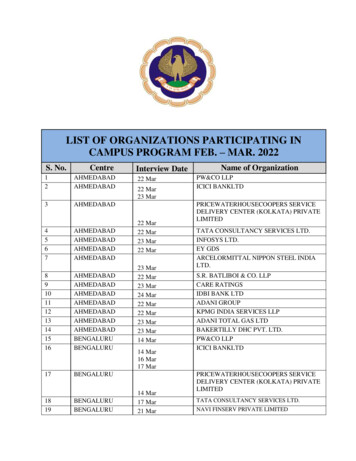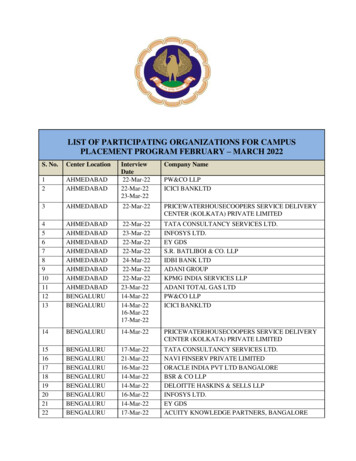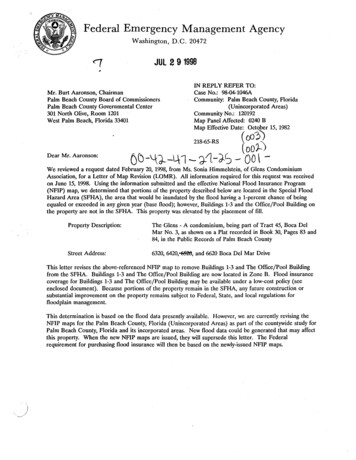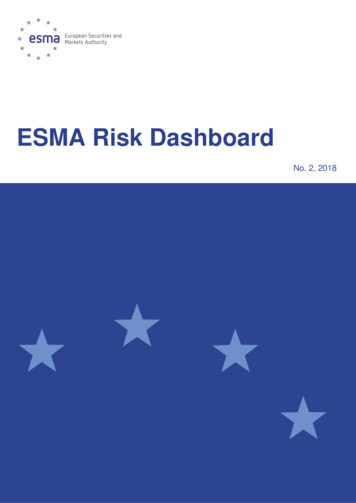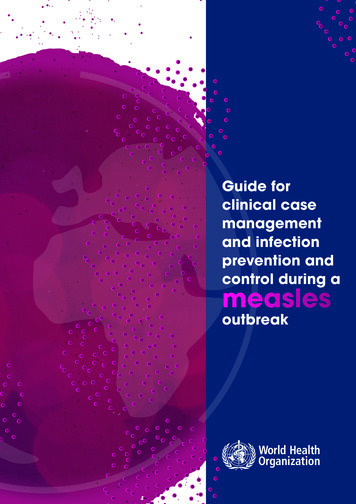
Transcription
Guide forclinical casemanagementGuide for clinicalcasemanagementandand infectioninfectionpreventionprevention andcontrol andduring a measlesoutbreakcontrolduring ameaslesoutbreak
Guide forclinical casemanagementand infectionprevention andcontrol during ameaslesoutbreak
Guide for clinical case management and infection prevention and control during a measles outbreakISBN 978-92-4-000286-9 (electronic version)ISBN 978-92-4-000287-6 (print version) World Health Organization 2020Some rights reserved. This work is available under the Creative Commons Attribution-NonCommercial-ShareAlike 3.0 IGO licence (CC BY-NC-SA 3.0 IGO; igo).Under the terms of this licence, you may copy, redistribute and adapt the work for non-commercial purposes, provided the work is appropriately cited, as indicated below. In anyuse of this work, there should be no suggestion that WHO endorses any specific organization, products or services. The use of the WHO logo is not permitted. If you adapt the work,then you must license your work under the same or equivalent Creative Commons licence. If you create a translation of this work, you should add the following disclaimer alongwith the suggested citation: “This translation was not created by the World Health Organization (WHO). WHO is not responsible for the content or accuracy of this translation. Theoriginal English edition shall be the binding and authentic edition”.Any mediation relating to disputes arising under the licence shall be conducted in accordance with the mediation rules of the World Intellectual Property Organization.Suggested citation. Guide for clinical case management and infection prevention and control during a measles outbreak. Geneva: World Health Organization; 2020. Licence:CC BY-NC-SA 3.0 IGO.Cataloguing-in-Publication (CIP) data. CIP data are available at http://apps.who.int/iris.Sales, rights and licensing. To purchase WHO publications, see http://apps.who.int/bookorders. To submit requests for commercial use and queries on rights and licensing, seehttp://www.who.int/about/licensing.Third-party materials. If you wish to reuse material from this work that is attributed to a third party, such as tables, figures or images, it is your responsibility to determinewhether permission is needed for that reuse and to obtain permission from the copyright holder. The risk of claims resulting from infringement of any third-party-owned componentin the work rests solely with the user.General disclaimers. The designations employed and the presentation of the material in this publication do not imply the expression of any opinion whatsoever on the part ofWHO concerning the legal status of any country, territory, city or area or of its authorities, or concerning the delimitation of its frontiers or boundaries. Dotted and dashed lines onmaps represent approximate border lines for which there may not yet be full agreement.The mention of specific companies or of certain manufacturers’ products does not imply that they are endorsed or recommended by WHO in preference to others of a similar naturethat are not mentioned. Errors and omissions excepted, the names of proprietary products are distinguished by initial capital letters.All reasonable precautions have been taken by WHO to verify the information contained in this publication. However, the published material is being distributed without warrantyof any kind, either expressed or implied. The responsibility for the interpretation and use of the material lies with the reader. In no event shall WHO be liable for damages arisingfrom its use.Design and layout by L’IV Com SàrlPrinted in Switzerland
ContentsAcknowledgements. . ivAbbreviations. . . v1. Introduction. . 11.1 Target audience. . . 11.2 Key recommendations. 12. Objectives. . . . 33. Background. 43.1 Disease. . 43.2 Clinical presentation. . 43.3 Complications. . 44. Public health surveillance case definitions and classifications. . 55. Clinical management and infection prevention and control measures. . . 75.1 Early recognition/triage of patients with clinically suspected measles or severe illness. . . . 85.2 Early infection prevention and control: apply standard and airborne precautions. 95.3 Immediate administration of vitamin A. . 115.4 Symptomatic treatments for prevention of complications. . . 125.5 Early supportive care for sepsis/severe illness. . . 136. Managing measles exposures. 196.1 Health care workers. . 196.2 Patients. . 19References. . . . . . . 20Annex 1. Key criteria to assess nutrition and vital signs in children. 22Annex 2. Classification of dehydration. . 24iii
AcknowledgementsThis document was developed by the Essential Programme on Immunization (EPI) Unit of the Departmentof Immunization, Vaccines and Biologicals (IVB) of the World Health Organization (WHO). The followingindividuals have contributed to the production of the guide and their inputs are acknowledged with sinceregratitude.Expert panelDale Fisher (co-chair, Global Outbreak Alert and Response Network [GOARN] chair); Srinivas Murthy(co-chair, University of British Columbia, Canada); Kulkanya Chokephaibulkit (Mahidol University, Thailand);Dianne Crellin (University of Melbourne, Australia); Vu Quoc Dat (Hanoi Medical University, Viet Nam);Nicola Gini (Starship Children’s Hospital, Auckland, New Zealand); Timothy Gray (Concord RepatriationGeneral Hospital, New South Wales, Australia); Richard Kojan (The Alliance for International Medical Action[ALIMA], Senegal); Hans-Joerg Lang (University of Witten/Herdecke, Germany); Paula Lister (SunshineCoast University Hospital, Australia); Peter Prager (University of Queensland, Australia); Helena Rabie(Stellenbosch University, South Africa); Naoki Shimizu (St Marianna University School of Medicine, Japan).Note: All members of the expert panel completed conflict of interest forms and none reported a conflictof interest.Médecins Sans Frontières: Tanja Ducomble.United Nations Children’s Fund: Maria Otelia Costales, Imran Mirza, Yodit Sahlemariam.United States Centers for Disease Control and Prevention: Jeffrey McFarland, Mark Papania, Robert Perry.WHO: April Baller, Diana Chang Blanc, Janet Diaz, Santosh Gurung, Jose Hagan, Lee Lee Ho, DraganJankovic, Sudhir Khanal, Katrina Kretsinger, Margaret Lamunu, Ann Lindstrand, Laura Nic Lochlainn,Balcha Girma Masresha, Mick Mulders, Susan Norris, Katherine O’Brien, Maria Clara Padoveze, DesireePastor, Minal Patel, Lisa Rogers, Alex Rosewell, Wilson Milton Were, Nasrin Musa Widaa.ivGuide for clinical case management and infection prevention and control during a measles outbreak
AbbreviationsAIIRairborne infection isolation roomARDSacute respiratory distress syndromeBPblood pressurebpmbeats per minuteCLIAClinical Laboratory Improvement AmendmentsCPAPcontinuous positive airway pressureCRTcapillary refill timeHCWhealth care workerHEPAhigh-efficiency particulate airHIVhuman immunodeficiency virusHRheart rateIOintraosseousIPCinfection prevention and controlISOInternational Organization for StandardizationIVintravenousNSnormal salineORSoral rehydration saltsPEPpost-exposure prophylaxisPPEpersonal protective equipmentRLRinger’s lactateRRrespiratory rateSOPstandard operating procedureSpO2peripheral oxygen saturationSSPEsubacute sclerosing pan encephalitisWHOWorld Health OrganizationAbbreviationsv
1 IntroductionThis guide has been developed to reduce the high morbidity and mortality seen in some of the currentoutbreaks of measles. This short guide outlines practical clinical care interventions and is derived frompreviously published WHO documents, including the WHO Pocket book of hospital care for children (1),WHO Paediatric emergency triage, assessment and treatment (2), and other international guidelines suchas the Surviving Sepsis Campaign: international guidelines for the management of sepsis and septicshock: 2016 (3).1.1 Target audienceThis guide is intended for front-line clinicians and health care workers (HCWs) who care for clinicallysuspected or confirmed measles in any health care setting. This guide will also aid policy-makers andhospital managers to ensure policies are in place to safely provide necessary life-saving care to measlespatients.1.2 Key recommendations1. All suspected cases of measles should be reported to public health authorities as mandated. Publichealth authorities in many countries request reporting of all patients with fever and maculopapular(non-vesicular) rash as suspected measles cases, whereas clinicians may form a differentialdiagnosis which includes clinically suspected measles based on their experience, clinical suspicionand the epidemiological country context. This guide applies to clinically suspected or confirmedmeasles cases.2. Hospitals and public health authorities should update the existing infection prevention and control(IPC) guidelines to include specific IPC measures and airborne precautions for measles.3. Ensure that all HCWs have presumptive evidence of measles immunity. Two doses of measles viruscontaining vaccine are recommended if no evidence of measles immunity exists.4. Prioritize the hospitalization of and airborne precautions required for patients with clinical warningsigns. Non-severe measles cases should receive outpatient treatment and be isolated at home, withlimited exposure to non-immune people, and be administered vitamin A as recommended.5. Patients with clinically suspected measles or other clinical warning signs should be admitted toa treatment facility with isolation capacity – a single room is preferred. If this is not possible, thensafeguard cohort patients in confined areas, separating clinically suspected and confirmed cases.1. Introduction1
6. For all suspected measles cases among children under 5 years of age, administer one dose ofvitamin A immediately on diagnosis and administer a second dose the next day, according to theage-specific dosing guidelines (Table 5.2). A third dose should be given 4–6 weeks later if anyclinical signs of vitamin A deficiency, such as xerophthalmia, including Bitot’s spots and cornealulceration, present themselves.7. In adults with measles, vitamin A may be of value, particularly in specific populations in whichpatients may have vitamin A deficiency. Women of reproductive age in whom vitamin A deficiency issuspected should only be treated with lower, but more frequent, doses.8. Patients with measles are at high risk for complications, and thus careful care of eyes, mouth andskin is necessary to prevent secondary infections. Ensuring adequate nutrition is essential.9. Severe manifestations or complications of measles should be managed using the same standardsused in non-measles patients. When available, use local or national patient care guidelines,including antibiotic guidelines.10. Administering prophylactic antibiotics is not recommended in adults and children with measles.However, early empiric antibiotics should be considered for suspected secondary bacterialinfections.11. There is insufficient evidence to make a recommendation for the routine use of antivirals (ribavirin)in adults and children with measles.12. It is important to work with public health authorities to evaluate exposed HCWs, patients and visitorsfor presumptive evidence of measles immunity and take necessary actions including administrationof post-exposure prophylaxis (PEP).2Guide for clinical case management and infection prevention and control during a measles outbreak
2 ObjectivesDuring an outbreak, early and adequate treatment and clinical case management of clinically suspectedmeasles patients is essential to reducing measles morbidity and mortality. The implementation of infectionprevention and control (IPC) measures is important to prevent HCW infections, reduce transmission inhealth care settings, and reduce the risk of spread to vulnerable populations. Clinical management andinfection control measures should not be delayed while waiting for laboratory confirmation of measles.This short guide aims to improve the care of patients with clinically suspected or confirmed measles andto prevent health care-associated infections nosocomial transmission.2. Objectives3
3 Background3.1 DiseaseMeasles is one of the most contagious diseases in humans. It is caused by a paramyxovirus virus, genusMorbillivirus. Measles transmission is primarily person to person via large respiratory droplets. Airbornetransmission via aerosolized droplet nuclei has been documented in closed areas for up to 2 hours aftera person with measles occupied the area (4).3.2 Clinical presentationThe incubation period for measles is usually 10–14 days (range 7–23 days), measured from exposureto onset of fever. The disease is characterized by prodromal fever, rash, cough, red inflamed eyes(conjunctivitis), or runny nose (coryza), and the presence of Koplik’s spots (reddish spots with a whitecentre) on the buccal mucosa. The characteristic erythematous maculopapular rash appears 2–4 daysafter onset of the prodrome, beginning on the face and becoming generalized and lasting 4–7 days. Skinpeeling is common after resolution of the rash.3.3 ComplicationsComplications associated with measles most commonly involve the respiratory and/or digestive tracts:otitis media, pneumonia, laryngotracheobronchitis (croup), diarrhoea and stomatitis. Dehydration canresult from either reduced oral intake from stomatitis, increased losses from diarrhoea, or both. Measlescan also be complicated by febrile seizures, especially in older children and adults, and post-infectiousencephalitis. Vitamin A levels fall significantly during measles, and in children with pre-existing deficiencyor malnutrition, measles can result in xerophthalmia, including inflammation of the cornea (keratitis),Bitot’s spots and keratomalacia. Subacute sclerosing pan encephalitis (SSPE), a progressive degenerativedisease due to persistent measles virus infection of the brain, occurs in five to ten cases per million reportedmeasles cases an average of 7 years after acute measles (range 1 month to 27 years). Many case seriesof adult measles patients also report hepatitis as a complication. Measles infection during pregnancy isassociated with an increased risk of complications, including miscarriage, preterm birth, neonatal lowbirth weight and maternal death. In populations with malnutrition, overcrowding and lack of access tohealth care, measles mortality can be as high as 2–15%.4Guide for clinical case management and infection prevention and control during a measles outbreak
4 Public health surveillancecase definitions andclassificationsTable 4.1. Case definitions to be used for public health surveillance (5)12Suspected measles caseA suspected case is one in which a patient with fever and maculopapular (non-vesicular) rash, or inwhom a health care worker suspects measles.Laboratory-confirmed measlesA suspected case of measles that has been confirmed positive by testing in a proficient laboratory,1 andvaccine-associated illness has been ruled out.Epidemiologically linked measlesA suspected case of measles that has not been confirmed by a laboratory, but was geographically andtemporally related with dates of rash onset occurring 7–23 days apart from a laboratory-confirmedcase or another epidemiologically linked measles case.Clinically compatible measlesA suspected case with fever and maculopapular rash and at least one of cough, coryza or conjunctivitis,but no adequate clinical specimen was taken, and the case has not been linked epidemiologically to alaboratory-confirmed case of measles or other communicable disease.Non-measles discarded caseA suspected measles case that has been investigated and discarded as non-measles through:negative laboratory testing in a proficient laboratory on an adequate specimen collected during theproper time after rash onset;epidemiological linkage to a laboratory-confirmed outbreak of another communicable disease thatis not measles, i.e. confirmation of another etiology;failure to meet the clinically compatible measles case definition.Measles outbreakA single laboratory-confirmed measles case should trigger an aggressive public health investigationand response in an elimination setting. An outbreak is defined as two or more laboratory-confirmedcases that are temporally related (with dates of rash onset occurring 7–23 days apart) andepidemiologically or virologically linked, or both.2A proficient laboratory is one that is WHO-accredited or has established a recognized quality assurance programme, such as International Organization for Standardization(ISO) or Clinical Laboratory Improvement Amendments (CLIA) certification.Criteria for epidemiological linkage include being a known contact, being in the same physical setting as the case during their infectious period for any length of time(shared enclosed air space such as at home, school, health facility waiting room, transport or workplace). Note, the virus remains contagious in the air or on infectedsurfaces for up to 2 hours; this should be considered when conducting contact tracing as transmission can occur even if the contact was not in the same room at the exactsame time as the case. In some investigations, contacts are considered those sharing an enclosed air space with a case within 2 hours of when the case was there.4. Public health surveillance case definitions and classifications5
Box 1. Clinical medicine and public health surveillance: they’re not the same thing!Public health surveillance is done for a variety of reasons: for example, to identify an outbreak or tounderstand if the intervention (e.g. vaccine) is working. As measles can range from mild to severeillness, public health authorities in many countries request that all cases with fever and rash arereported. This helps to ensure that every case of measles is identified – even atypical ones. However,clinicians form a differential diagnosis based on their experience and the country context. They mightor might not think a case which meets the public health suspected case definition of measles is trulymeasles. That’s acceptable – but those cases must still be reported to public health authorities.Most health facilities cannot nor should not implement measles treatment and IPC protocols forevery case of fever and rash. Instead, it is more reasonable for health facilities to screen for clinicallysuspected measles, such as someone who presents with fever, rash and either cough, conjunctivitis orcoryza. If someone meets this clinical definition, then they should be isolated from other patients, andclinical judgement should be used to decide if the likely cause of illness is measles. In that situation,the guidance provided in this document should be used for case management and IPC.6Guide for clinical case management and infection prevention and control during a measles outbreak
5 Clinical management andinfection prevention andcontrol measuresTopicsEarly recognition/triage of patients with clinical suspected measles or severe illnessEarly infection prevention and control: apply standard and airborne precautions– Update existing IPC guidelines– Health care worker immunization– Health care worker training– Administrative controls– Ensure early recognition, notification and source control– Single room or cohort with clinically suspected or confirmed cases– Environmental cleaning and waste managementImmediate administration of vitamin A– Children– AdultsSymptomatic treatments for prevention of complicationsEarly supportive care for sepsis/severe illness– Assessment and re-assessment: interpret and respond– Diarrhoea and severe dehydration– Use of prophylactic antibiotics– Severe pneumonia and acute respiratory distress syndrome– Sepsis and shock– Croup/upper airway obstruction– Antiviral treatments5. Clinical management and infection prevention and control measures7
5.1 Early recognition/triage of patients with clinicallysuspected measles or severe illnessCould this patient have measles? A clinically suspected measles case is illness in a patient in whom a health care worker suspects measles (e.g. a patient with fever andmaculopapular (non-vesicular) rash, especially with cough, coryza, conjunctivitis or Koplik’s spots), especially in the context of a knownmeasles outbreak. Check travel histories to document whether a clinically suspected measles patient has recently travelled to or been in contact withsomeone who has recently travelled to a country with a measles outbreak.IPC interventionyes Clinically suspected case of measles. Collect samples (serum and urine or throat swabs) for laboratoryconfirmation – mark request as urgent.Are there ANY of the following clinical warning signs? convulsions lethargy or unconsciousness respiratory distress, grunting severe chest wall indrawing inability to drink or breastfeed vomiting all oral intake corneal clouding deep or extensive mouth ulcers dehydration stridor due to measles croup severe malnutrition.yes Hospitalization/inpatient treatment.Administer vitamin A.Administer antibiotics for sepsis.Supportive care and close monitoring.noConsider the differential diagnosis.no NO admission/outpatienttreatment. Limit exposure to non-immunepeople. Administer vitamin A asrecommended.High-risk group: If patient has no signs of severeillness, but is from a high-risk group, considerhospitalization for close monitoring for development ofcomplications: Age: infants and adults older than 20 years of age. Pregnant women. Undernourished children (particularly those withvitamin A deficiency). Persons with suppression of cellular immunity (thosewith cancer, taking immunosuppressive medicationsor with HIV infection). In HIV cases, measles viralshedding can be very prolonged.WHAT TO DO IF YOU SUSPECT MEASLES1. Give the patient a medical-surgical facemask to wear.2. Isolate in a single room – preferably negative pressure.3. Collect samples (serum and urine or throat swabs) for laboratory confirmation – mark request as urgent.4. Tell the IPC officer.5. Conduct triage and prioritize admission of severe cases.Fig. 5.1. Screening and triage for measles during outbreak8Guide for clinical case management and infection prevention and control during a measles outbreak
5.2 Early infection prevention and control: apply standard andairborne precautionsUpdate existing IPC guidelinesHospitals and public health authorities should update the existing IPC guidelines to include specific IPCmeasures and airborne precautions for measles (6,7).Health care worker immunizationEnsure that all HCWs have presumptive evidence of measles immunity, which may include writtendocumentation of two doses of measles-containing vaccine, laboratory evidence of immunity or previousdisease (i.e. measles IgG positive in serum); equivocal results are considered negative. Two doses ofmeasles virus containing vaccine are recommended if no evidence of measles immunity.Health care worker trainingProvide all HCWs with job-specific training on basic concepts of measles transmission, case management,including early recognition of clinical suspected cases and IPC measures on prevention of measlestransmission. Ensure HCWs are educated and can demonstrate use of personal protective equipment (PPE)appropriately, according to risk evaluation, prior to caring for measles cases. Train all HCWs after receivingmedical clearance on the use of tight-fitting respirators (N95 or equivalent), which must be fit tested.3Administrative controlsPlace visual aids (signs, posters) about respiratory etiquette (cover nose and mouth when coughing/sneezing with tissue or medical-surgical facemask, dispose of used tissues and masks, and perform handhygiene after contact with respiratory secretions) and medical-surgical masks at the facility entrance andin common areas (e.g. waiting rooms). Provide supplies to perform hand hygiene and make available toall persons in the facility. Ensure standard operating procedures (SOPs) for infection control in hospitalsand health settings are available. Perform routine audits and feedbacks on isolation practices to ensureHCWs are performing them correctly. Develop plans for safely receiving measles cases, either sporadicor in outbreaks. Where possible, facilities may plan for providing dedicated entrances, examination roomsand exits for clinically suspected cases, or even separate dedicated buildings.Ensure early recognition, notification and source controlWhere possible, while scheduling appointments for clinically suspected measles cases by phone, provideinstructions for arrival, including which entrance/facility to use and what precautions to take (e.g. how tonotify hospital staff, don a medical-surgical facemask upon entry, follow triage procedures). It is importantto check travel histories to establish whether patients with clinically suspected measles have recentlytravelled to or been in contact with someone who has recently travelled to a country with a measlesoutbreak. In low-resource setting, the health centre staff should immediately notify the next administrationlevel up, for example, district or province, using the quickest available means of communication inaccordance with local procedures. The notification form should include available information on name, age,sex, clinical symptoms, date of rash onset, date of specimen collection, vaccination status, travel historyand residence. If cases are reported along border areas, health officials in the adjoining areas should benotified and efforts should be made to share information. Notify the receiving facility in advance whentransporting clinically suspected cases. Use dedicated triage stations; clinically suspected cases shouldbe immediately isolated upon identification. In areas where isolation rooms are not available, a separatearea or structure for clinically suspected measles patients should be used. Isolation should continue untilthe case is discharged, or for 4 days after rash onset, whichever is first.3Fit testing is one of the most important parts of the respirator programme because it is the only recognized tool to assess the fit of a specific respirator model and size to theuser’s face.5. Clinical management and infection prevention and control measures9
Prioritize the hospitalization and airborne precautions of patients with clinical warning signs as indicated inFig. 5.1. Non-severe measles cases should receive outpatient treatment and be isolated at home, althoughin some settings where isolation areas are available, the patients can be under observation for 24 hours.Limit exposure to non-immune people. Ensure that patients with confirmed or clinically suspected measlesdo not remain in outpatient departments and other areas where they may infect vulnerable individuals(infants, immune-compromised etc.). Provide patients with confirmed or clinically suspected measleswith a medical-surgical facemask and separate these individuals from non-measles patients prior to or assoon as possible upon entering a health care facility. Limit transport of patients with clinically suspectedand confirmed measles to essential reasons only, and if movement is unavoidable then use all necessaryprecautions (medical-surgical facemask on patient).Single room or cohort with clinically suspected or confirmed casesImmediately place patients with known or clinically suspected measles in a separate area until examined orin an airborne infec
Nicola Gini (Starship Children's Hospital, Auckland, New Zealand); Timothy Gray (Concord Repatriation General Hospital, New South Wales, Australia); Richard Kojan (The Alliance for international Medical Action [ALiMA], Senegal); Hans-Joerg Lang (University of Witten/Herdecke, Germany); Paula Lister (Sunshine
